International Journal of Wireless and Microwave Technologies @ijwmt
Статьи журнала - International Journal of Wireless and Microwave Technologies
Все статьи: 574
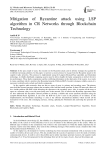
Mitigation of Byzantine attack using LSP algorithm in CR Networks through Blockchain Technology
Статья научная
In the past couple of years, the research on the Byzantine attack and its defense strategies has gained the worldwide increasing attention. In this paper, we present a secure protocol to escape from the Byzantine attack in the cognitive radio networks. This protocol is implemented using the Lamport-Shostak-Pease algorithm and blockchain technology. A reliable distributed computing system must be able to handle the faulty components to deliver the error less performance. These faulty components send the conflicting information to the other parts of the system. As a result, it creates a problem which is similar to the Byzantine Generals Problem (BGP). In order to design a reliable system, it is necessary to identify and overlook such faulty components. In the cognitive radio networks, there are the two types of users i.e. primary and secondary users. The primary users hold the licensed spectrum whereas the secondary users hold the leased spectrum. In these CR networks, there can be a similar problem like BGP while allocating the spectrum to the secondary users. Also, it requires all the users to agree on a common value, even with some faulty users in the network. This is called as the Byzantine Agreement. Here we have addressed this Byzantine General problem to develop a reliable and secure spectrum allocation using the Lamport-Shostak-Pease algorithm. It can solve the BGP for n≥3m+1 users in the presence of ‘m’ faulters. In this implementation, the blockchain technology is used as the efficient decentralized database which records all the transactions of the users, like exchanging currency, mining, updating the blockchain and auctioning the spectrum for lease.
Бесплатно
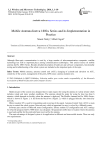
Mobile Antenna Inetvu 1800+ Series and its Implementation in Practice
Статья научная
Although fiber-optic communication is used by a large number of telecommunication companies, satellite technology has still its important place among communication technologies. This article focuses on mobile antenna InetVu 1800+ Series. Besides detailed description of hardware and software components, functionality testing and troubleshooting of the whole system are included as the important parts of the topic.
Бесплатно
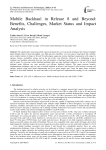
Mobile Backhaul in Release 8 and Beyond: Benefits, Challenges, Market Status and Impact Analysis
Статья научная
The significantly increasing mobile capacity demand, the use of advanced techniques like enhanced multiple input multiple output to boost throughput, very high data rate, reliability, very low latency, long battery life, mobility, and to enable internet of things in 4G and 5G technologies, aggravate extreme backhaul requirements with respect to capacity, latency, availability, energy, and on the top of this, cost efficiency. However, it is challenging to get a complete one backhaul technology that can solve all problems of backhaul especially massive introduction of small cells in mind. To overcome various backhaul problems there are many backhaul solutions i.e. the use of diversified backhaul under different use cases provides cost efficient backhaul solution. This paper presents benefits, implementation challenges, and use cases of mobile backhaul in release 8 and beyond. It also presents coverage and capacity analysis using excel based dimensioning tool for a given sample area. Lastly the paper shows economic benefits of diversified backhaul for small and macro cells and high-level implementation strategy for the considered area.
Бесплатно
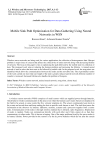
Mobile Sink Path Optimization for Data Gathering Using Neural Networks in WSN
Статья научная
Wireless sensor networks are being used for various applications for collection of heterogeneous data. Hotspot problem is major issue of concern that affects the connectivity of entire network along with decreasing lifetime of network. The focus in this paper is lies on optimizing the path followed by the mobile sink for collection of data. The proposed work aims at reducing the hotspot problem and increasing the lifetime. A trained neural network is used to select the best route to be followed by mobile sink. In the proposed work, the stop points are identified which allow the communication between the nodes and the movable sink. The experimental results of the work carried out show that tour length of the sink is greatly reduced and the network lifetime (number of rounds) is increased. Increased lifetime also handles the problem of hotspots.
Бесплатно
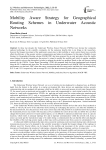
Mobility Aware Strategy for Geographical Routing Schemes in Underwater Acoustic Networks
Статья научная
In those last decades the Underwater Wireless Sensor Network (UWSNs) have become the commonly explored technology by the scientific community, for the numerous benefits that it can brings to the researchers, however the frequent movement of the underwater sensors due to their mobility or water current factor may severally affect the efficiency of the acoustic wireless communication and reduce it performance. In this paper a Mobility Aware Strategy for Geographical Routing scheme (MAGR-VBF) has been proposed for an early prevention from the mobile sensor during the packet transmission, the protocol is aimed to predict the mobility and switch to another candidate sensor enable to recover the data packet in order to mitigate the packet loss problem. Based on the well-known routing protocol for the UWSNs ‘Vector Based Forwarding’ (VBF) the proposed study has been implemented and designed using the NS-2 simulator and Aqua-Sim. The result has shown that the presented work (MAGR-VBF) has brings a good performance over the basic VBF, where the energy consumption and the average end to end delay have been reduced by 8.97 % and 5.55 % respectively, and an average of 6.16 % has been increased of packet delivery ratio metric.
Бесплатно
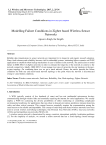
Modelling Failure Conditions in Zigbee based Wireless Sensor Networks
Статья научная
Reliable data transmissions in sensor networks are important for its longevity and require research attention. Since, fault tolerance and reliability become vital for embedded systems, estimating failure scenarios aid WSN applications to establish robust backup mechanisms in case of failures in the network. The article aims to model failure in IEEE 802.15.4 Zigbee networks in order to estimate the longevity of the network in context to the network connectivity. Ideally, IEEE 802.15.4 can manage two types of networks, the star topology or the peer-to-peer topology. On combining these two we get a mesh network. Hence, the article presents the failure conditions for both star and mesh based network topology to the point where the network is disconnected owing to varied failure conditions.
Бесплатно

Modelling Manufacturing System Controller-based Siphon Petri Nets
Статья научная
This work is focused on the deadlock prevention problem for a class of Flеxіble Мanufaсturing Ѕyѕt-еms(FMSѕ) which is modelled by Ѕyѕtems of Ѕimple Ѕequential Рrοсesses with Reѕοurces (S3PRs), baѕed on Petri net mοdels. Petri Nets (PNs) gives a strong framework of modelling resources shared between concurr-ent processes in FMSs. This paper deals design methodology of controllers based on the Petri nets for the synthesis of FMSs based on a siphon PNs analysis is to be controlled by the set of minimal siphons which are generate a new P-Semifiow. We distinguish siphons in PN to give the necessary impact on the final supervisor control scheme that is the basis siphon structure analyzed to control FMS. The experimental approach is Siphon PN to give an effective tool for the liveness network, which gives a typical analysis to solve deadlock prevention in FMSs models are checked by PNs. Successful implementation of an FMS corresponds to synthesize a PN is to compute process models in parallel systems that have been specified to deadlock detection. In our application, the examples of an FMS are a control system by PN.
Бесплатно
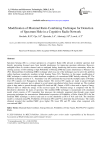
Статья научная
Spectrum Sensing (SS) is a critical operation in a Cognitive Radio (CR) network to identify spectrum hole thereby preventing licensed users from harmful interference for improving spectrum utilization. However, multipath effects in wireless channel such as multipath fading, shadowing and receiver uncertainty affect the sensing accuracy of CR resulting to high Probability of Missing (PM) that causes interference to Primary User (PU). Maximal Ratio Combining (MRC) technique which was one of the techniques used to solve this problem suffers hardware complexity resulting in high Sensing Time (ST). Therefore, in this paper, modification of MRC technique is carried out to reduce hardware complexity of conventional MRC thereby reducing ST. The modified technique consists of ‘L’ Secondary User (SU) antennas that received the multiple copies of Primary User (PU) signals over Nakagami-m fading channel. The received PU signals are made to passed through separate channel estimator and co-phased to avoid signal cancellation before been summed up. The resultant signa is then made to passed through single RF chain and MF. Output of MF is then used as input to Energy Detector (ED) to obtain the energy of the received signal. The obtained energy is compared with the set threshold to determine the status of spectrum. The modified MRC technique is incorporated with simulation model which consists of PU transmitter that processes the randomly generated data through some signal processing techniques for transmission. Mathematical expression of Probability of False Alarm (PFA) for the modified MRC technique is derived and used to set the thresholds at PFA of 0.01 and 0.05. The modified model is evaluated using PM, Probability of Detection (PD) and PT to determine the performance. The results obtained revealed that modified MRC gives higher PD, lower PM and PT values when compared with conventional MRC.
Бесплатно
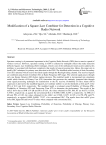
Modification of a square-law combiner for detection in a cognitive radio network
Статья научная
Spectrum sensing is of paramount importance in the Cognitive Radio Network (CRN) due to massive spread of wireless services. However, spectrum sensing in CRN is affected by multipath effects that make detection difficult. Square- Law Combining (SLC) technique, which is one of the methods previously used to address this problem, is associated with hardware complexity that results in long processing time. Hence, this paper aim to modify SLC technique for primary user detection in the CRN. The modified model consists of three Secondary User (SU) antennas which receive the faded signals through the Rayleigh fading channel. The received signals are combined using Switch Combiner (SC) at Radio Frequency (RF) stage. The selected signal passes through only one Energy Detector (ED) before making decision. The modified model is incorporated into simulation model which consists of Primary User (PU) transmitter that processes the randomly generated data through some signal processing techniques for transmission to the SU receiver. Probability of False Alarm (PFA) expression is derived for the modified Square-Law Combiner (mSLC) to set the thresholds at 6.64 and 9.14 for PFA of 0.01 and 0.02, respectively. The modified model is evaluated using Probability of Missing (PM), Probability of Detection (PD) and Processing Time (PT) to determine the performance. The results of the mSLC show that at SNR of 4 dB and PFA of 0.01, the values obtained for PD, PM, PT are 0.6575, 0.3530, 5.5540 s, respectively, as against the conventional SLC of 0.4000, 0.600, 6.2055 s, respectively. At SNR of 4 dB and PFA of 0.02, the values obtained for the mSLC are 0.7600, 0.3457, 6.1945 s for PD, PM and PT, respectively, as against 0.4000, 0.6000, 7.2197 s for conventional SLC. The results show that mSLC gives lower PM, higher PD and lower PT values when compared with conventional SLC.
Бесплатно

Modified Output Combining 3-Stage Doherty Power Amplifier Design for LTE Micro eNodeB
Статья научная
This paper presents a highly efficient modified output combining 3-stage Doherty Power Amplifier (DPA) design using low power LDMOS transistor for Band 40, TD-LTE Micro eNodeB. In this design, modified output combining technique has been used in the output section which meets the output power requirements of Micro eNodeB which cannot be achieved by conventional 3-stage DPA. The modified DPA design achieves 65.3% power added efficiency (PAE) at 39 dBm average output power with 20 MHz LTE signal using 15 watt LDMOS Transistor. 3-stage modified output combining technique increases the linear output power by 1.1 dB and increases the Gain flatness versus power level. The use of Digital Pre-Distortion (DPD) along with modified 3-stage DPA design achieves the linearity requirements as per the 3GPP specifications. The modified DPA combining technique has provided potential economical solution by using low power LDMOS transistor with an advantage of high efficiency.
Бесплатно
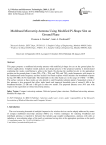
Multiband microstrip antenna using modified pi-shape slot on ground plane
Статья научная
This paper proposes a multiband microstrip antenna with modified pi-shape slot cut on the ground plane for wireless applications. Complete modal analysis and design process of the proposed antenna is demonstrated explaining the modes contributing to achieve the bands. By placing the modified pi-slot in the appropriate position on the ground plane, it tunes TM10, TM12, TM02 and TM20 and TM22 mode frequencies with respect to the fundamental mode frequency and thus realizes four band response which includes one broadband response having 164 MHz (6.5%) bandwidth. The bandwidth in the other bands are in the range of 6 MHz - 30 MHz. The surface currents at these modes are also altered to yield broadside radiation pattern. Suspended version of this antenna is also proposed that offers triple bands and improved broadside gain of around 4 dBi at the broadband besides 2.5 dBi and 1 dBi gain at other two modes. The proposed antenna saves 56% area with respect to the equivalent un-slotted microstrip antenna.
Бесплатно

Multipath Cluster-based Hybrid MAC Protocol for Wireless Sensor Networks
Статья научная
The WSN (Wireless Sensor Network) is the most appearing expertise that has potential applications broad ranges that include environment examining, smart spaces, medical systems, and robotic study. The efficient energy is a consideration of vital design for WSN. In WSNs, the collision is occurred due to data transmission from the sensor nodes and the traffic at SINK node is high due to the transmission of excess data by the sensor nodes. An important division of the consumption of resources in a WSN is managed by the mechanism of MAC (Medium Access Control). An existing MAC protocols initiated for the utilization of WSNs single channel for the transmission of data. This is basically because of the reality that efficient energy is measured to be the issue of essentiality in WSNs. A new multi-channel MAC procedure MPCB-HM is proposed which utilizes CSMA/CA (Carrier Sense Multiple Access/ Collision Avoidance), to exchange the data, the activity of TDMA (Time Division Multiple Access) sequencing nodes and also FDMA (Frequency Division Multiple Access) to allow collision-free exchange simultaneously. The nodes have multiple communication channels, so that the high data traffic can be shared in multiple channels. This reduces the overhead in the nodes and the Energy consumption is minimized by this method and collision free transmission is achieved. With the help of intra-cluster communication and inter-cluster communication, the MAC mode control is responsible for shifting of mode from TDMA to CSMA and vice versa. The Cluster-based topology is implemented which helps in improving the scalability and energy efficiency. By utilizing the simulator of NS2, the process is estimated and the outcomes have shown that the procedure of MAC is improved by overall network presentation compared to the other protocols.
Бесплатно
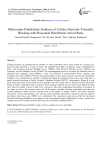
Статья научная
Cellular networks are characterized by mobility in which subscribers move freely within the coverage area. Since the radio spectrum is a scarce resource, the available bandwidth is divided by using a combination of Time- and Frequency-Division Multiple Access (TDMA) Code Division Multiple Access (CDMA) and Frequency Division Multiple Access (FDMA). For communication process to succeed, the subscriber must be allocated some frequency band (FDMA), a time slot (TDMA) or pseudorandom binary sequence that modulates the carrier (CDMA). With the increasing number of users, these resources may become unavailable, leading to new call blocking or handover call blocking. Erlang B and Erlang C have been used in the past to model teletraffic blocking in Public Switched Telephone Network (PSTN). Unfortunately, Erlang B is only ideal when subscribers do not perform call re-attempts after their initial calls are blocked. On the other hand, Erlang C model is applicable only in networks where queuing is applied and can easily lead to higher blocking rates when the number of users is high. This is because it takes into consideration the number of instances in the queue as well as the resources under use. In this paper, teletraffic blocking probabilities that take into account additional cellular network concepts such as the number of mobile stations, call retries, channels reservation, overlays and underlays, user velocity, relative mobility, call priority, call arrival rates and signal to interference plus noise ratio (SINR) were synthesized. The simulation results showed that the developed teletraffic blocking probabilities were superior to the conventional Erlang B and Erlang C as they consider new concepts that exist in cellular networks that were not envisioned in traditional PSTN.
Бесплатно
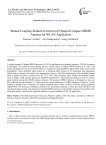
Mutual Coupling Reduction between H Shaped Compact MIMO Antenna for WLAN Application
Статья научная
A simple compact H shaped MIMO antenna for WLAN application at resonating frequency 5.8 GHz is propose in this paper. The center to center spacing between closely placed H shaped MIMO antenna is 0.311λo. The mutual coupling between the proposed antenna is reduced by using dumbbell shaped DGS at the center of the groundplane. These dumbbell shape defect act as bandstop filter because of its inductance and capacitance effect, helps to suppress the surface wave propagation of waves. The filter characteristic of the dumbbell shaped DGS is studied to achieve isolation over the 5.725-5.875 GHz frequency band. Further the parametric study such as length, width and the spacing of dumbbell shaped DGS is optimized and studied in order to achieve good isolation among the MIMO antenna elements. The proposed MIMO structure is fabricated on low cost FR4 substrate having thickness of 1.6mm and the overall dimension of MIMO antenna is 40mm x 24 mm leading to compact size of antenna. The mutual coupling reduces from 24 dB to 34 dB by placing dumbbell shaped DGS. The envelope correlation coefficient for the proposed antenna is below less than 0.04 dB for the operating frequency band. The proposed H shaped MIMO antenna is tested and the measured result follows the simulation results. Therefore the proposed antenna is a good candidate for WLAN application.
Бесплатно
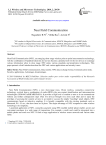
Статья научная
Near Field Communication (NFC), an emerging short-range wireless point to point interconnection technology, with the combination of handheld electronic device has become a potential tool for the two devices to exchange various information when in close range. NFC unites various standards and proprietary technologies. This paper presents a brief introduction about the NFC and various applications and security issues.
Бесплатно
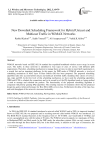
New Downlink Scheduling Framework for Hybrid Unicast and Multicast Traffic in WiMAX Networks
Статья научная
WiMAX networks based on IEEE 802.16 standard has expedited broadband wireless access surge in recent years. The traffic in these networks is identified in four types of class of service with different QoS requirements. Therefore, scheduling mechanism to manage these services in order to meet QoS requirements is a crucial fact and an important challenge. In this paper, for PMP mode of WiMAX networks, a two-level scheduling mechanism in MAC layer of Base Station (BS) has been proposed. The proposed scheduling algorithm takes into account hybrid unicast and multicast downlink traffic including three classes of service: rtps, nrtps and BE. In the first level of this scheduling mechanism, we have used the scheduling algorithms WRR and FCFS to schedule the connections and in its second level, the PQ algorithm based on Aging method is used to manage and schedule the packets. The functionality of the proposed scheduling algorithm is compared with priority queuing (PQ) algorithm. The resulting outcome of simulation shows that the proposed design has quite a better performance for Best Effort (BE) service class. Furthermore the delay of the rtps class and total throughput of the network is increased noticeably.
Бесплатно
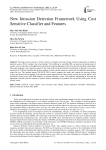
New Intrusion Detection Framework Using Cost Sensitive Classifier and Features
Статья научная
The huge increase amount of Cyber Attacks in computer networks emerge essential requirements of intrusion detection system, IDS to monitors the cybercriminals. The inefficient or unreliable IDS can decrease the performance of security services and today world applications and make the ongoing challenges on the Cyber Security and Data mining fields. This paper proposed a new detection system for the cyber-attacks with the ensemble classification of efficient cost sensitive decision trees, CSForest classifier and the least numbers of most relevant features are selected as the additional mechanism to reduce the cost. The standard dataset, NSL-KDD, IDS is used to appraise the results and compare the previous existing systems and state-of-the-art methods. The proposed system outperforms the other existing systems and can be public a new benchmark record for the NSL-KDD datasets of intrusion detection system. The proposed combination of choosing the appropriate classifier and the selection of perfect features mechanism can produce the cost-efficient IDS system for the security world.
Бесплатно
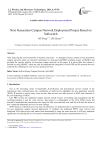
Next Generation Campus Network Deployment Project Based on Softswitch
Статья научная
After analyzing the current networks of Guizhou University,we brought forward a scheme of next generation campus networks based on softswitch technology by choosing SoftX3000 switching system of HuaWei and provided the specific solution of accessing campus networks in this paper. It is proved that this scheme is feasible by using OPNET, which not only accomplished the integration of the PSTN and IP networks but also achieved the combining of voice services and data services.
Бесплатно
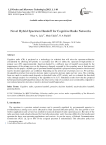
Novel Hybrid Spectrum Handoff for Cognitive Radio Networks
Статья научная
Cognitive radio (CR) is projected as a technology (or solution) that will raise the spectrum utilization considerably by allowing low-priority or secondary user (SU) to utilize the spectrum of high-priority or primary user (PU) opportunistically. Spectrum handoff is a different type of handoff necessitated by the reappearance of the primary user on the frequency channels occupied by the secondary user at that time and location. In this paper, a hybrid type of spectrum handoff algorithm is proposed where proactive decision and reactive decision approaches are combined. Depending on the arrival rate of primary user (i.e. PU activity), the algorithm switches from reactive decision mode to proactive decision mode and vice versa. The switching from one mode to another mode depends on threshold value of PU activity and we evaluated the threshold value through analysis for switching of the algorithm to be 0.37. Simulated results show that the proposed hybrid spectrum handoff algorithm reduces the total service time of secondary user considerably compared to conventional proactive decision or reactive decision handoff approaches.
Бесплатно

Novel Machine Learning Approaches for Identifying Attacks in IoT-based Smart Home Environment
Статья научная
Attackers keep launching different attacks on computer networks. Signature-based and Machine Learning (ML)-based techniques have been used to build models for promptly identifying these attacks in networks. However, ML-based approaches are more popular than their counterparts because of their ability to detect zero-day attacks. In the Internet of Things (IoT), devices are interconnected and this called for the need to guide such networks against intrusions. This study aims at building effective ML models from a recently released IoT-based Smart Home dataset. The study revealed patterns and characteristics of the IoT dataset, pre-processed it and then selected discriminant features using Binary Bat Algorithm (BBA). The pre-processing of the Smart Home IoT dataset for the study was carried out based on the issues identified during the exploratory analyses. The experimental evaluation carried out revealed that all the learning algorithms achieved promising classification results. For instance, Decision Trees recorded 98.60% accuracy, KNN produced 99.60% accuracy while Random Forest (RF) and AdaBoost-based models recorded 100.00% and 99.91% respectively. In all other metrics, RF-based attack classification model slightly recorded the best results. The study concluded that the EDA, innovative data pre-processing, BBA-based feature selection improved the classification performances of the ML approaches used in this study.
Бесплатно

